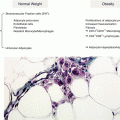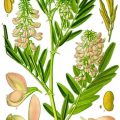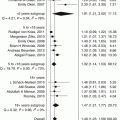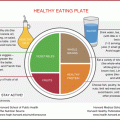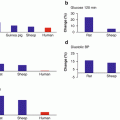Fig. 14.1
Hormonal changes as a consequence of changing macronutrient composition
If dietary carbohydrate content in the diet is too high, this will generate excess in insulin production. If this is coupled with high levels of omega-6 fatty acids, this can lead to increased cellular inflammation. At the other extreme when the carbohydrate content is too low, this can generate ketosis with corresponding rise in cortisol [25]. Between these two hormonal extremes lies a zone in which insulin levels and blood sugar levels are stabilized resulting in greater satiety and less fatigue.
Another important question that has to be addressed is the level of calories required for an anti-inflammatory diet to be successful. This is important since it has been shown that the consumption of excess calories also creates inflammation in the hypothalamus leading to increased appetite [26].
14.7 History of Anti-inflammatory Diets
The first anti-inflammatory diet was proposed in the book, The Zone, published 20 years ago [19]. The central focus of this anti-inflammatory diet was one that was based on a bell-shaped curve of the protein-to-glycemic load described in Fig. 14.1. In addition there was a strong emphasis to reduce the levels of omega-6 and saturated fats with most of the fats in the diet coming from noninflammatory monounsaturated fats.
The midpoint of the protein-to-glycemic load for this anti-inflammatory diet had a slight excess of carbohydrates to low-fat protein. When the overall fat content was factored in the overall composition of the anti-inflammatory diet, it would be approximately 40 % low-glycemic-load carbohydrates, 30 % low-fat protein, and 30 % fat high in monounsaturated fats and low in omega-6 and saturated fatty acids. However, this proposed anti-inflammatory diet was also a calorie-restricted one to prevent the inflammatory effect of excess calories. Thus, the absolute levels of the various macronutrients of the proposed anti-inflammatory diet are shown in Table 14.1 at various total caloric intakes. The usual recommendation for females would be 1,200 cal per day and 1,500 cal per day for males.
Table 14.1
Macronutrient amounts of an anti-inflammatory diet at various caloric levels
Macronutrient | 1,200 cal/day | 1,500 cal/day |
|---|---|---|
Carbohydrate | 120 g/day | 150 g/day |
Protein | 90 g/day | 112 g/day |
Fat | 40 g/day | 50 g/day |
It can be seen from Table 14.1 that at these caloric levels, the absolute levels of protein are adequate, the absolute levels of low-glycemic-load carbohydrates are moderate (although the volume on the plate would be significant), and the absolute levels of fats would be considered low. The macronutrient composition on a gram basis is 1 g of fat (primarily monounsaturated fats) for every 2 g of low-fat protein and 3 g of low-glycemic-load carbohydrates (primarily non-starchy vegetables and fruits).
14.8 Clinical Support for an Anti-inflammatory Diet
The first clinical trial to support such a macronutrient ratio in treating diabetics was reported in 1998 [27]. In this study, it was demonstrated that insulin resistance was significantly reduced within 4 days and before any weight loss. Carefully controlled clinical trials at Harvard Medical School in 1999 gave further support to the rapid hormonal changes and improvement in satiety using such the same macronutrient ratio in overweight children [28]. Researchers at Harvard Medical School confirmed these findings in satiety in 2000 in overweight adults [29]. More recent studies at Harvard Medical School have demonstrated that this macronutrient ratio is superior in reducing inflammation compared to isocaloric high-carbohydrate diets, even though the weight loss is identical [30].
In 2007, the Joslin Diabetes Center at Harvard Medical School announced their new dietary guidelines for treating obesity, metabolic syndrome, and diabetes [31]. These guidelines in terms of macronutrient composition and calorie content were virtually identical to those proposed more than a decade earlier [19]. Subsequent studies and other publications from the Joslin Diabetes Research Foundation have supported this anti-inflammatory diet concept [32, 33].
Numerous other clinical studies of this anti-inflammatory diet having 40 % of calories as carbohydrates, 30 % the calories as protein, and 30 % of calories as fat have demonstrated superior weight loss, fat loss, improved insulin levels, increased fat loss, increased satiety, and most importantly reduction of cellular inflammation [34–39].
From a visual standpoint, the composition of the plate for each meal is shown in Fig. 14.2.
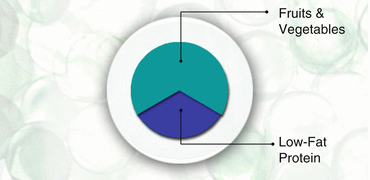

Fig. 14.2
Visual composition of typical anti-inflammatory meal
At every meal, the plate should be divided into three equal sections. On one section should contain low-fat protein approximately the size and thickness of the palm of the hand. Appropriate protein choices would be chicken, fish, or protein-rich vegetarian sources. The other two-thirds of the plate should be filled with colorful carbohydrates (primarily non-starchy vegetables and limited amounts of fruits). This will simultaneously maintain a low glycemic load as well as provide adequate levels of polyphenols. Finally, the ideal added fat would be a dash of extra virgin olive oil (approximately 5 ml). The hormonal success of this dietary balance will be indicated by the lack of hunger and maintenance of mental acuity for the next 5 h.
14.9 Clinical Markers of Inflammatory Risk and Their Ideal Ranges
There are three clinical markers that are important to achieve for an anti-inflammatory diet to be considered successful. Each of these markers relates to a different component of the inflammatory response, and all three markers should be within appropriate ranges to truly ensure that cellular inflammation is being managed.
14.9.1 AA/EPA Ratio
The first of these markers is the AA/EPA ratio. As discussed earlier, this is the first clinical marker that cellular inflammation is beginning to increase. The ideal ratio should be between 1.5 and 3. The average AA/EPA ratio in the Japanese population is 1.5 [40], whereas it is 18 in the average American population [41]. If the AA/EPA is less than 1, then the potential for bleeding increases, although there is significant reduction of cardiovascular events compared to the use of statins [42]. As long as the AA/EPA ratio remains above 1.2, there is no indication of any increased bleeding [43].
14.9.2 TG/HDL Ratio
14.9.3 HbA1c
Glycosylated hemoglobin is a marker of long-term blood glucose control and is an indicator that type 2 diabetes is developing. It is generally accepted that HbA1c levels of greater 6.5 % is indicative of diabetes and increasing mortality [46]. However, the optimal level of HbA1c should be 5 % as lower levels are also associated with increased mortality [47].
These optimal ranges are shown in Table 14.2.
Table 14.2
Clinical markers of an anti-inflammatory diet
Clinical maker | Optimal range |
|---|---|
AA/EPA ratio | 1.5–3 |
TG/HDL ratio | <1 (mg/dl) or <0.4 (mmoles/ml) |
HbA1c | 5 % |
All three clinical parameters must be within their optimal ranges to ensure the cellular inflammation is being controlled. If not, either a more strict anti-inflammatory diet should be employed, or the addition of anti-inflammatory supplements should be considered.
14.10 Potential Use for Anti-inflammatory Supplements
Often even a strict anti-inflammatory diet sometimes will not be sufficient to reach the desired ranges of the clinical markers described above. Under these circumstances, there are two additional anti-inflammatory supplements to consider.
14.10.1 Omega-3 Fatty Acids
The most important of these anti-inflammatory supplements would be highly refined omega-3 fatty acids that will help reduce the AA/EPA ratio and thus increase pro-resolution potential of the diet. The definition of a highly refined omega-3 fatty acid product would be one that has very low in PCB levels (5 ppb or lower). This is because all fish and the fish oils derived from them contain PCBs, which are known endocrine disruptors [48, 49].
A suggested serving would be about 2.5 g of supplemental EPA and DHA per day. However, the ideal dosage will be determined by titrating the blood levels of the mother to an appropriate AA/EPA ratio between 1.5 and 3. Adequate levels of these omega-3 fatty acids are critical not only for the proper neurological development of the fetus but also in reducing existing cellular inflammation in mother.
14.10.2 Polyphenol Extracts
As mentioned earlier, fruits and vegetables contain polyphenols. At high enough concentrations, polyphenol extracts can activate AMP kinase via interaction with the SIRT-1 gene [5, 23]. AMP kinase can be considered the central molecular switch that controls metabolism including blood glucose control. The supplementation with purified polyphenol extracts can further increase AMP kinase activity. An appropriate dose would be 500–1,000 mg of polyphenols per day.
14.11 Summary
Reducing the potential problems during pregnancy is best accomplished by first identifying high-risk populations with existing metabolic dysfunction caused by diet-induced inflammation and then working with such populations to reduce cellular inflammation by the use of an anti-inflammatory diet as described above. There are various time points at which such dietary interventions might be contemplated.
14.11.1 Peri-conception
The best time to prepare for the dramatic hormonal changes caused by pregnancy is lower cellular inflammation prior to conception. This is true for both parents. The rise in IVF treatments is an indication of the increasing difficulty of successful conception.
14.11.2 Pregnancy
It is known that the maternal diet can have significant effect on fetal programming with dramatic influence on the future health of the child [50–57]. The more closely a mother follows an anti-inflammatory diet, the better the future outcome for the child.
Stay updated, free articles. Join our Telegram channel

Full access? Get Clinical Tree


